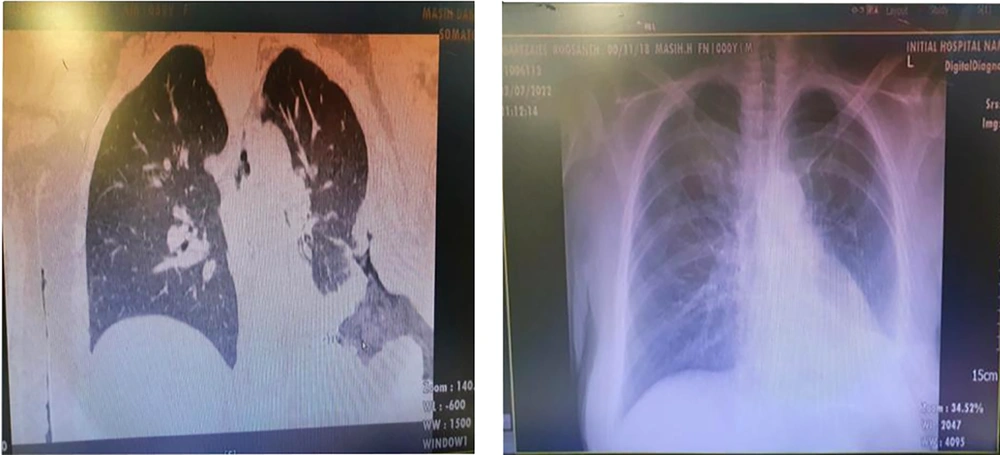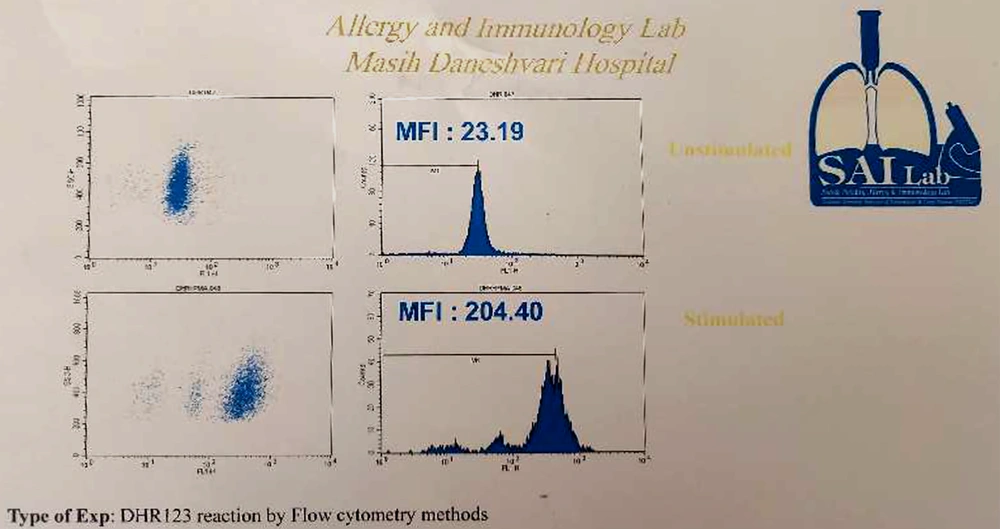1. Introduction
Chronic granulomatous disease (CGD) is a primary immunodeficiency with an increased susceptibility to recurrent infections and inflammatory manifestations (1). It is the most common inherited phagocytic disorder with defective nicotinamide adenine dinucleotide phosphate (NADPH) oxidase. This oxidase is essential for the clearance of phagocytized pathogens by the respiratory burst mechanism (2). Females normally have two populations of neutrophils, each expressing paternal and maternal X chromosomes. In female mammals, one X chromosome becomes randomly silenced early in the developmental process to allow the expression of only one X chromosome, namely lionization, to make the female X chromosome equivalent to that of males (3). Considering the aforementioned mechanism, in female X-linked CGD carriers, neutrophils with inactivated cytochrome B-245 beta chain (CYBB) mutated X chromosome will have normal respiratory burst, and those with inactivated normal X chromosome will express the CGD phenotype. Although most female carriers of X-linked CGD have been considered to be unaffected, it has been revealed that they may have similar problems to those of CGD patients (4). In most cases, the carrier state in CGD patients is associated with autoimmunity (3). Other manifestations such as recurrent infections, skin diseases (including photosensitive rash, folliculitis, postadolescent acne, eczema, and oral aphthous ulcers), and gastrointestinal manifestations (such as abdominal pain, intermittent diarrhea, rectal bleeding, and chronic inflammatory bowel disease) are also reported. In a study by Marciano et al., most of the female carriers did not show severe bacterial or viral infections, but two of them had multiple miscarriages (3).
This case study suggests that CGD carriers may have extensive clinical manifestations and remain undiagnosed for years. The goal is to emphasize that the CGD carrier state might be more complex than it was previously appreciated.
2. Case Presentation
A 54-year-old woman visited the Department of Allergy and Immunology at our hospital in June 2021 due to left lobe pneumonia (LLP) and pleural effusion. Chest computed tomography (CT) scan revealed LLP, flap, and mediastinal lymphadenopathies (Figure 1).
Radiography and computed tomography (CT) scan of thorax without intravenous (IV) contrast. Evidence of the left-sided Eloesser flap with mild visceral and parietal pleural thickening in the lower lobes can be observed in the CT scan image. Other parts of the lung parenchyma are insignificant. Linear atelectasis of the left lower lobe with patchy consolidation can also be seen.
Her complete blood count was normal, except for anemia, with a hemoglobin of 10.2. Her high-grade fever, chills, and hemoptysis symptoms in July 2020 were initially attributed to a hydatid cyst. Thus, she underwent a lobectomy, resulting in purulent drainage in the excision site on the skin, refractory to local and systemic treatments, including oral antibiotics, repeated wound debridement, and flap surgeries. Keloid lesions developed after some time, indicative of the chronicity of the wound. At the same time, a diagnosis of lung cancer was also suggested without any available pathology document. The culture of the secretions was indicative of Gram-positive rods known as diphtheroids. Since this type of poor wound healing is normally attributed to neutrophil defects, particularly CGD, we planned to perform immunodeficiency screening tests, the results of which were within normal limits (see below).
She had a history of three uncomplicated pregnancies. However, at the age of 30 years, she underwent a total abdominal hysterectomy due to massive menorrhagia.
The refractory and recurrent nature of the lesions led to the evaluation of her immune system. The immunological evaluation was completely normal, with a 100% nitroblue tetrazolium (NBT) and a dihydrorhodamine (DHR) of 278 (normal > 100). Further DHR123 flow cytometry investigations with multiple stimulants revealed a carrier state of CGD in this patient, which was compatible with her history of chronic complications (Figure 2). No relevant family history was reported.
3. Discussion
This study is a report of a woman with no history of severe infections until her sixth decade of life. She underwent lung lobectomy at the age of 54 years; however, as the wound on the surgical site did not heal in a timely manner, various immunodeficiency tests were performed, the results of which were indicative of her CGD carrier state.
Inborn errors of immunity are a group of heterogeneous disorders characterized by severe and recurrent infections, as well as autoimmune and inflammatory diseases (5). Chronic granulomatous disease is a primary immunodeficiency disease with the inability to generate reactive oxygen species (ROS), leading to defective respiratory burst during phagocytosis and defective microbial killing. The most frequent abnormality resulting from mutations in the CYBB gene located on the X chromosome causes defects in gp91phox. Chronic granulomatous disease used to be diagnosed by the NBT test, but as this test is prone to subjectivity, it has been replaced by DHR as the best current diagnostic tool. Dihydrorhodamine also provides information about the most likely inheritance pattern of CGD (6). In the carrier state of CGD, a causal relationship exists between skewed inactivation of the wild-type allele and the risk of infection, with the risk being dose-dependent on the DHR value percentage (3). Infections in carriers are reported to occur when the percentage of functional neutrophils reaches 10% or below (7). By contrast, the inflammatory and autoimmune manifestations are not related to the DHR percentage or the overall superoxide production amount but are associated with the CGD carrier state alone (3).
Female carriers diagnosed by the DHR assay usually show a bimodal pattern indicating two populations of neutrophils, one positive and one negative for gp91phox expression and function (2). Similar to other female carriers of X-linked recessive diseases, it was previously thought that CGD female carriers are clinically healthy and asymptomatic. However, it has been shown that X-CGD carriers with functioning neutrophils ranging from 5 to 30% are prone to infections, while there is no cause-and-effect relationship between the susceptibility to autoimmune or inflammatory manifestations and the amount of baseline oxidative burst function (2).
The CGD carrier state may present itself only with nonspecific symptoms, including skin rash on the face, hands, and chest, sensitivity to the sun, joint pain and swelling, fatigue, and weight loss. Over time and by aging, the immune system may work less efficiently, so CGD-related signs and symptoms may start to show up, leading to a clinically significant disease.
Some other significant manifestations observed in CGD carriers include recurrent vaginal infections, recurrent lower urinary tract infections, recurrent rhinopharyngitis, pneumonia, liver abscess, and hidradenitis suppurativa.
3.1. Conclusions
Adult patients with unusual manifestations suggestive of neutrophil function defects in adulthood should be evaluated for the CGD carrier state. In these cases, NBT alone may miss the diagnosis of CGD. In such cases, DHR testing with multiple stimulants may establish a robust diagnosis.

